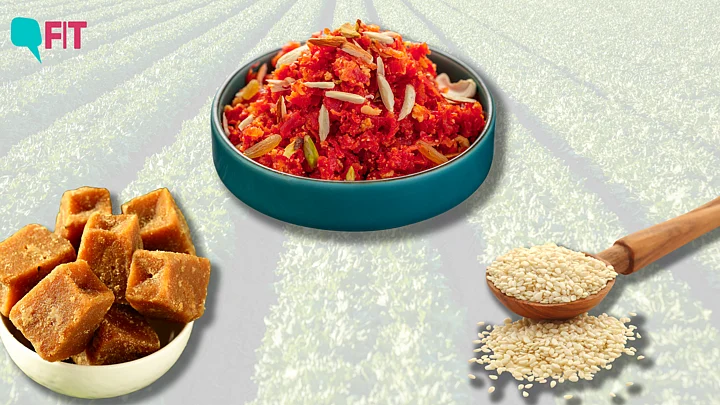Having grown up in north India, my winter days often consisted of eating makhan malai, kali gajar ka halwa, breakfast with a side of dry fruits, gajak, til ke ladoo, moongfali, and (much to my dismay) many different kinds of green leafy vegetables.
When I look back at my winter vacations in Lucknow, it surprises me to recall that there have been days where I’ve preferred to eat a handful of peanuts over an aloo paratha or a steaming bowl of rajma chawal (both of which I can easily devour, regardless of how full I might be).
What also surprises me, each time I think about it, is the vast variety of ‘winter food’ and ‘winter recipe’ options that we have.
But where does the concept of a seasonal nutritional overhaul come from? Why do we change the way we eat according to the changes in the weather?
Why Seasonal Nutritional Overhauls Make a Difference
Avantii Deshpaande, a nutritionist based in Pune, tells FIT that it’s always better to opt for the local fresh produce that is available during the season.
There are multiple reasons for this:
One is, of course, that the seasonal produce is fresh. Not only that, Deshpaande adds, “The nutritional value is also much higher in the seasonal produce and gives much more nourishment to your body.”
Your digestive fire is very different in the winter and summer seasons.
During the winter, you need foods that can keep your body warm, generate body heat, and provide you with energy. For instance – til (sesame seeds), gud (jaggery), or bajra (pearl millet).
On the other hand, in the summer, you need more fruits with water content to stay hydrated and give you the required dose of electrolytes.
“When the temperatures fall, eat more cooked food and avoid eating raw food. Your body might not be able to digest raw food that well and you might develop gas.”Avantii Deshpaande
Arnab Ghosh, a lawyer-turned-chef and nutritionist, agrees with her. He tells FIT:
“Multiple studies have shown that the body responds to cycles in nature (and geographic regions) which affect key metrics such as hours of sleep, calories burnt, and other circadian rhythms. Aligning with seasonal produce addresses these changing needs of the body.”
Getting Started: Small Steps Towards Health & Taste
But when you’ve been living away from home for many years, you tend to fall out of the habit of seasonally changing your diet (at least that’s what happened in my case).
While my mother cooks bathua and sarson ka saag at home in the winter, I usually cook whatever vegetable is in the fridge and might go bad if I don’t use it up that very day.
However, if you do what to get back on track towards seasonal eating, here are some things that can perhaps help you get started.
Go to the local markets and pick fresh seasonal fruits and vegetables, instead of ordering the same two veggies online every time (note to self as well).
In the Delhi winter, you can relish oranges, guavas, grapes, etc. If you’re somewhere in Maharashtra, try the famous Mahabaleshwar strawberries.
Read up about the seasonal produce available in the region you’re residing in and try those.
Try to incorporate some of your family recipes or the foods you grew up eating in your everyday diet.
You can also try newer recipes from blogs or channels that operate in your region, which require the seasonal produce as ingredients.
It won’t just help you. According to a 2014 study published in the Proceedings of the Nutrition Society, seasonal eating is a sustainable way of helping the environment as well.
Winter Foods That Warm Your Heart: From My Mother’s Kitchen
In India, we have different foods for every season, and there’s clearly no dearth of options.
Deshpaande says that while the consumption of ladoos made out of sesame seeds and jaggery, and root vegetables (like potatoes, carrots, radish, etc) increases in north India, in Maharashtra, it’s dishes like Bhogi sabzi and Surti papdi that adorn the plates. In Gujarat, it’s dishes like Undhiyu.
But since I’m being nostalgic about foods that I grew up eating in the December-January ki kadake wali thand, I called up my mother to find out the recipes to my favourite winter desserts.
Straight from your mother’s kitchen to your screen:
Chikki
Lightly roast cashews, almonds, pistachio, walnuts, coconut, melon seeds, and poppy seeds in a pan. Take it out of the pan. Put ½ spoon of desi ghee and ¾ cups of sugar, and caramelise it till it turns slightly red. Add the roasted dry fruits back to it. Mix.
Grease a mould with a spoon of desi ghee. Add the mixture to the mould. Let it rest for 10-15 minutes. Cut it in smaller pieces and serve.
Gajar Ka Halwa
Wash, peel, and grate ½ kg of carrots. Take 1-1.5 spoons of desi ghee in a pan. Add the grated carrots in the pan and lightly roast it. Add around 600 gms of milk. Keep mixing it till the milk is well incorporated.
Add 2 spoons of sugar. Add cashews, almonds, and raisins to your liking. Lightly roast it again for 2-4 minutes or till the sugar is well incorporated. Add around 100 gms of khoa. Keep mixing it for 5 minutes. Serve warm.
(At The Quint, we question everything. Play an active role in shaping our journalism by becoming a member today.)
